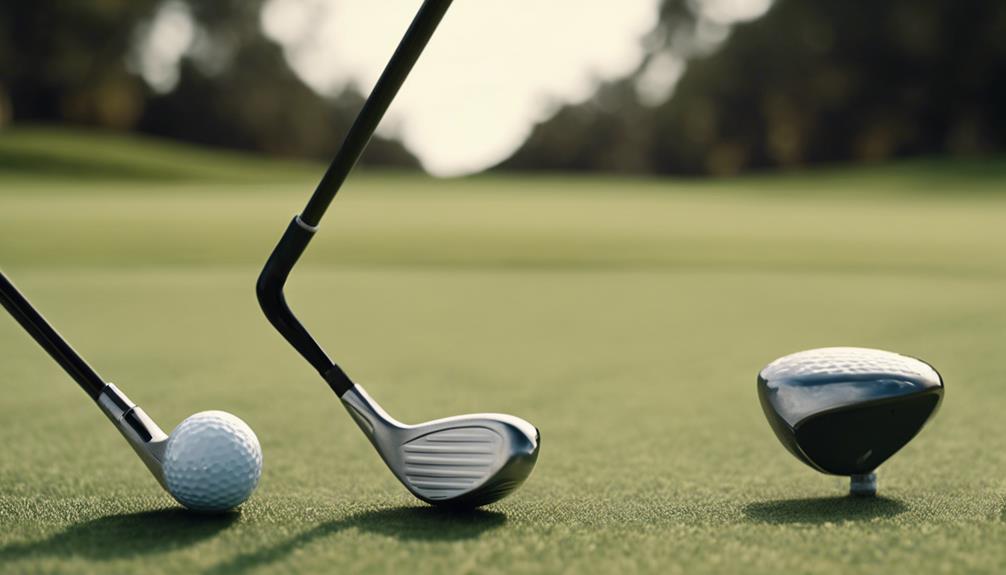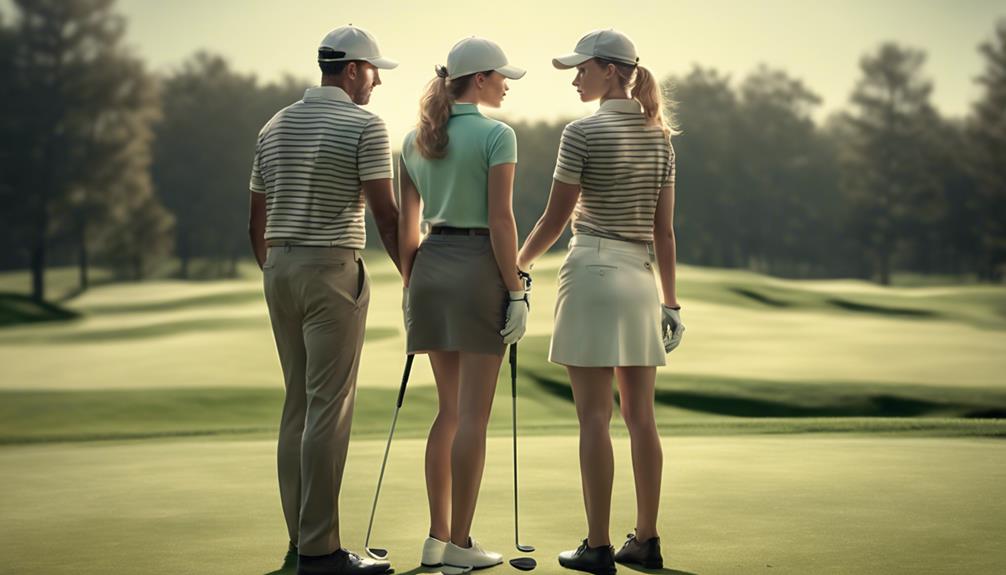- 7 Top Flite Golf Clubs XL for Improved Performance - September 28, 2024
- Top Flite Golf Clubs: Top 5 Reasons to Choose Them - September 28, 2024
- Top 3 Golf Club Fitters for a Perfect Swing - September 28, 2024
You'll find that golf clubs designed for men and women differ in several key aspects, including clubhead design, shaft flexibility, grip size, and weight distribution, all tailored to accommodate distinct swing characteristics, physical attributes, and playing styles. Women's clubs typically feature lighter graphite shafts, larger and more forgiving clubheads, and higher loft angles to compensate for slower swing speeds. They also have shorter shafts, smaller grips, and weights that average 20-40 grams less than men's clubs. As you explore the nuances of golf club design, you'll discover how these differences can impact your game and uncover the perfect fit for your unique swing.
Key Takeaways
- Women's golf clubs have lighter graphite shafts to accommodate slower swing speeds and generate more clubhead speed.
- Clubheads are often larger and more forgiving in women's clubs, featuring a greater sweet spot to reduce slicing and improve accuracy.
- Women's clubs have a higher loft angle to launch the ball higher and farther, compensating for slower swing speeds.
- Shafts in women's clubs are typically shorter, around ½-1 inch shorter than men's clubs, to accommodate slower swing speeds and smaller stature.
- Grips in women's clubs are generally smaller in diameter, catering to smaller hands, and often feature softer, more tactile materials for improved feel.
Club Design and Construction
When selecting a golf club, understanding the design and construction differences between men's and women's clubs is essential, as they cater to distinct swing characteristics and physical attributes.
You'll notice that women's golf clubs are designed with lighter graphite shafts, which accommodate slower swing speeds and generate more clubhead speed.
The clubheads themselves are often larger and more forgiving, featuring a greater sweet spot to reduce slicing and improve accuracy. This design tweak is vital, as it helps you maintain a consistent swing and hit the ball straighter.
In addition, the clubface of women's golf clubs is typically designed with a higher loft angle, which helps launch the ball higher and farther, compensating for slower swing speeds.
Shaft Length and Flexibility
As you consider the physical attributes and swing characteristics that influence your club selection, shaft length and flexibility emerge as critical factors to optimize your performance, particularly in light of the design differences you've just explored. Shaft length, for instance, is determined by the distance from your wrist to the ground, not your height or arm length. Women's clubs typically have shorter shafts, around ½-1 inch shorter than men's clubs, to accommodate slower swing speeds and smaller stature.
| Shaft Material | Flexibility | Benefits |
|---|---|---|
| Steel | Less flexible | More control, better for high swing speeds |
| Graphite | More flexible | Lighter, more forgiving, generates more clubhead speed |
| Hybrid | Balanced flexibility | Combines control and forgiveness |
Shorter clubs benefit golfers of both genders, especially beginners, by promoting a solid stance and improving strike and muscle deployment. Graphite shafts, being more flexible, are a popular choice for women's clubs as they provide a lighter and more forgiving option that can help generate more clubhead speed. By understanding the importance of shaft length and flexibility, you can make informed decisions about your club selection and take your game to the next level.
Clubhead Loft and Offset

When you're selecting golf clubs, bear in mind that the clubhead loft and offset are crucial factors, as these elements have a profound impact on your game.
You'll notice that women's clubs typically have higher loft angles, ranging from 12 to 15 degrees, which helps you launch the ball higher and farther.
As you examine the clubhead design, look for the offset distance, which affects the ball's trajectory and forgiveness.
Loft Angle Variations
You'll notice that golf clubs, whether designed for men or women, exhibit distinct loft angle variations that profoundly impact ball flight and overall performance.
The loft angle, measured in degrees, determines the trajectory of your shot.
Women's golf clubs typically feature higher lofts, ranging from 12 to 15 degrees, to help achieve higher ball flight and distance.
This is because women generally have slower swing speeds, requiring more lift to generate sufficient distance.
In contrast, men's drivers usually have lower lofts, around 9-10.5 degrees, due to their faster swing speeds and greater distance capabilities.
Loft angle variations can substantially impact ball flight, with higher lofts resulting in higher trajectories and shorter distances, while lower lofts produce lower trajectories and longer distances.
Offset Distance Effects
The offset distance between the clubhead's leading edge and the shaft's axis has a substantial impact on the club's overall performance, particularly in terms of forgiveness and accuracy. As you swing, the offset distance affects how the clubhead interacts with the ball, influencing the trajectory and direction of your shot.
Three key ways offset distance effects your game:
- Lie Angle: A larger offset distance can help reduce the likelihood of slicing, as it allows the clubhead to rotate more closed relative to the target line. This is particularly beneficial for golfers with a more upright swing plane.
- Club Length: A shorter club length can increase the offset distance, making it easier to hit the ball straight. This is why many women's clubs are designed with shorter shafts to accommodate their generally shorter swings.
- Forgiveness: A larger offset distance can increase the club's sweet spot, making it more forgiving on mis-hits. This is especially important for golfers who struggle with consistency, as it can help reduce the impact of slight mishits.
Grip Size and Style
Golfers require a grip size that fits comfortably in their hands, allowing for consistent control and precise swings.
When it comes to golf grips, men's and women's requirements differ markedly. You'll notice that women's golf grips are generally smaller in diameter, catering to their typically smaller hands.
A standard men's golf grip measures around 0.58 to 0.60 inches in diameter, while women's grips range from 0.55 to 0.58 inches.
This variation in grip size provides a more secure and comfortable hold, enabling you to generate consistent power and accuracy.
If you have smaller hands, you'll benefit from a smaller grip size. This is especially vital for women, as it allows for a more precise and controlled swing.
Golf clubs designed for women often feature grips with a softer, more tactile material to enhance feel and responsiveness.
By selecting a grip size that suits your hand size, you'll be able to maintain a consistent swing tempo and generate more power from your shots.
With the right grip size and style, you'll be well on your way to achieving mastery on the course.
Weight and Balance Differences

With women's clubs averaging 270-290 grams and men's clubs weighing in at 310-330 grams, significant weight differences exist between the two, impacting swing dynamics and overall performance. These weight differences have a direct impact on your game, particularly when it comes to clubhead speeds and distance.
Lighter graphite shafts in women's clubs help generate more clubhead speed and distance, compensating for slower swing speeds.
The balance point of women's clubs is often more towards the grip end, reducing twisting and promoting a more consistent swing.
Men's clubs have a more even balance point, allowing for more flexibility and control in the swing, which is ideal for their generally faster swing speeds.
These weight and balance differences are designed to accommodate the physical differences between men and women, such as strength, swing speed, and body size. By understanding these differences, you can choose the right club that suits your swing style and physique, ultimately improving your game.
Visual Design and Aesthetics
When choosing a golf club, you'll notice that manufacturers offer various visual design elements to suit your personal preferences.
You'll see that club head shapes differ substantially between models, and you'll need to decide whether a more traditional or modern shape suits your style.
Additionally, you'll have a range of color scheme options to select from, allowing you to customize the look of your clubs to fit your unique aesthetic.
Club Head Shapes
Selecting a club head shape that suits your swing style and personal preferences is essential, as it directly impacts your overall gaming experience.
Club head shapes can be broadly categorized into three main types, each with its unique characteristics and benefits.
Three key aspects to weigh when choosing a club head shape are:
- Oversized club heads provide a larger sweet spot, increasing forgiveness and accuracy. They're ideal for golfers with slower swing speeds or those who struggle with consistency.
- Tour-style club heads offer a more compact design, providing better control and workability. They're suited for skilled golfers who prioritize precision and accuracy.
- Hybrid club heads combine elements of both oversized and tour-style designs, offering a balance between forgiveness and control. They're perfect for golfers who want a versatile club that adapts to their swing style.
When selecting a club head shape, factor in your loft preferences as well.
A higher loft can help launch the ball higher and farther, while a lower loft provides a more penetrating trajectory.
Color Scheme Options
Golf clubs come in a variety of color schemes, each designed to appeal to different personal styles and preferences.
Manufacturers understand that aesthetics play a significant role in a golfer's purchasing decision.
Men's golf clubs often feature bold, darker colors such as black, silver, and navy blue, which evoke a sense of power and sophistication. These colors are often paired with subtle accents of red or orange to add a touch of aggression and energy.
Women's golf clubs, on the other hand, tend to incorporate brighter, more vibrant colors like pink, purple, and turquoise. These colors are designed to appeal to a feminine aesthetic and add a touch of elegance to the game.
Some manufacturers also offer more neutral options, such as white or gray, for golfers who prefer a more understated look.
Ultimately, the choice of color scheme depends on your personal taste and the overall style you want to achieve on the course. By offering a range of color options, manufacturers cater to the diverse preferences of golfers, allowing you to find the perfect clubs that reflect your unique personality and style.
Performance and Customization Options

With golf clubs designed specifically for men and women, performance and customization options become vital factors in optimizing your game.
As you consider the right golf club for your needs, understanding the unique features of each is paramount.
Compensating for Slower Swing Speeds: Women's golf clubs are designed to produce higher launch angles and more spin to compensate for slower swing speeds, resulting in shorter distances but more control and accuracy.
Customization for Individual Swing Styles: Customization options for women's golf clubs include lighter shafts, smaller grips, and more flexible heads to cater to individual swing styles and preferences.
Optimizing Weight and Flex: The right combination of weight and flex is key for women golfers, as this can have a profound impact on performance, with stronger women potentially benefiting from men's clubs or custom-fit clubs.
Frequently Asked Questions
How Do Women's Golf Clubs Differ From Men's?
When you compare women's and men's golf clubs, you'll notice differences in swing weight, clubhead design, and shaft flexibility, which are tailored to accommodate women's generally slower swing speeds and unique swing styles.
Can a Man Play With Women's Golf Clubs?
As you consider playing with women's golf clubs, coincidentally, your club performance is closely tied to your swing style. While gender stigma may not be an issue, it's essential to acknowledge that women's clubs are designed for slower swing speeds, potentially impacting your overall game.
What Is the Difference Between Men's and Women's Golf Wedges?
When choosing a golf wedge, you'll notice differences in wedge design, bounce angles, and shaft flex between men's and women's clubs. Women's wedges typically feature more upright bounce angles and softer shaft flex to accommodate slower swing speeds.
Should Tall Women Use Men's Golf Clubs?
"You're a towering golfer, crushing drives like a pro, but should you ditch your women's clubs for men's? Hold up, consider height adjustments, your unique swing style, and club preference – swapping clubs might not be the ace you think it is."
Conclusion
As you wrap up your exploration of golf clubs for men and women, it's likely no coincidence that you've discovered a common thread – clubs designed for women often prioritize forgiveness and ease of use, while men's clubs focus on power and precision.
With differences in design, construction, and customization, it's clear that each set is tailored to the unique needs and playing styles of its respective demographic.
By understanding these distinctions, you'll be better equipped to find the perfect set that suits your game.




